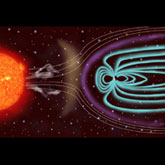X-ray Emissions From Comets
 The X-ray emission from comets is produced by high-energy particles, but the high-energy particles come not from the comet but from the sun. Matter is continually evaporating from the solar corona in a flow called the solar wind. The solar wind is composed of ions of hydrogen, helium and small percentages of heavier elements such as carbon, nitrogen and oxygen moving at speeds in excess of a million kilometers per hour.
The X-ray emission from comets is produced by high-energy particles, but the high-energy particles come not from the comet but from the sun. Matter is continually evaporating from the solar corona in a flow called the solar wind. The solar wind is composed of ions of hydrogen, helium and small percentages of heavier elements such as carbon, nitrogen and oxygen moving at speeds in excess of a million kilometers per hour.
When these ions, which have a large positive charge, collide with a comet, they can pull electrons away from the neutral atoms (predominantly hydrogen) of the comet in what is called a charge-exchange collision. The electrons are usually captured into high-energy states of the solar wind ions, and emit X-rays as they shift into lower energy states. These X-rays have an energy that is equal to the difference in energy states, and if detected with an X-ray spectrometer, provide a telling signal that the charge-exchange collision is occurring.
By observing comets, scientists will learn more about the chemistry of the solar wind and the cloud of dust and gas surrounding comets.
About the Author
Chandra X-Ray Observatory Center
 The Chandra X-ray Observatory, previously known as the Advanced X-ray Astrophysics Facility, is a Flagship-class space telescope launched aboard the Space Shuttle Columbia during STS-93 by NASA on July 23, 1999.
The Chandra X-ray Observatory, previously known as the Advanced X-ray Astrophysics Facility, is a Flagship-class space telescope launched aboard the Space Shuttle Columbia during STS-93 by NASA on July 23, 1999.


